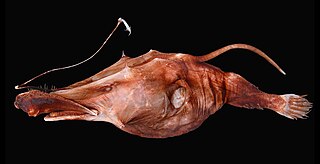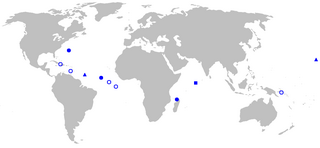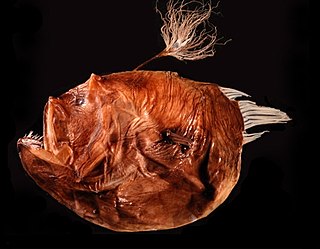
The footballfish form a family, Himantolophidae, of globose, deep-sea anglerfishes found in tropical and subtropical waters of the Atlantic, Indian, and Pacific Ocean. The family contains 23 species, all of which reside in a single genus, Himantolophus.

The dreamers are a family, Oneirodidae, of deep-sea anglerfishes in the order Lophiiformes. They are the largest and most diverse group of deep-sea anglerfish, and also the least well known with 16 genera represented by only one, two, or three female specimens. There are sixty-two species within the family, and that contains more females than males. They are found in deep, temperate waters around the world. They are small fish, the largest species only growing to about 20 cm (7.9 in) in total length. The largest female size that is known is about 370-mm and the largest known male is 16.5 mm. Females are dark brown to black all over their entire body, meanwhile males are also dark brown to black, but the nasal area is not pigmented for them. Female dreamers are found in a preservative dark brown to black color externally except for the escal appendages and distal portion of the escal bulb. Males are also the same color, except in their nasal areas.

Lasiognathus saccostoma is a species of wolftrap angler known from the eastern central Pacific Ocean and tropical waters of the Atlantic Ocean. It is found at depths to 4,000 metres (13,000 ft). The females of this species grow to a length of 7.7 centimetres (3.0 in) SL. This species has a slender, compressed prolongation at the tip of its elongated, cylindrical distal escal appendage, with numerous lateral serrations and distal filaments. Unlike in L. amphirhamphus, there are three escal hooks and they are darkly pigmented. The posterior escal appendage is broad and laterally compressed, and relatively larger than in L. amphirhamphus. No males or larval specimens have ever been found.
Spiniphryne, also called spiny dreamers, is a genus of dreamers. Like other deep-sea anglerfish, Spiniphryne lure prey to them by means of a modified first dorsal fin ray with a bioluminescent bulb at the tip. Spiniphryne is unique amongst the oneirodids for being covered in tiny spines.

Spiniphryne duhameli is a species of dreamer known from the central Pacific Ocean. The females of this species grow to a length of 11.7 centimetres (4.6 in) SL. The esca contains a pair of short, slender filaments at the tip, a small, simple appendage without distal filaments on the back, and three pairs of long, slender filaments on the sides. S. duhameli also has more dental teeth than S. gladisfenae.

Phyllorhinichthys is a genus of dreamers. Like other oneirodids, they are small, bathypelagic fish with bioluminescent lures. Phyllorhinichthys is unique amongst the deep-sea anglerfish in having a pair of fleshy, leaf-like structures on its snout.

Phyllorhinichthys balushkini is a species of dreamer found in the Atlantic Ocean. The females of this species grow to a length of 14.5 centimetres (5.7 in) SL. The illicium is longer than that of P. micractis. The esca bears a single forward appendage containing a pair of internal light-guiding tubes that diverge from each other at the tip. The rear escal appendage is extremely long, measuring over half the length of the fish, covered with dark skin and ending in a pair of translucent bulbs. The snout flaps are relatively small.
Phyllorhinichthys micractis is a species of dreamer that has been recorded from the Atlantic, Pacific and Indian Oceans. The females of this species grow to a length of 12 centimetres (4.7 in) SL. The illicium is shorter than that of P. balushkini. The esca has two forward appendages at the tip and the rear appendage is much shorter and stouter than that of P. balushkini. The available specimens vary in the number and presence of additional appendages and filaments. The size of the snout flaps are also highly variable.

Gigantactis is a genus of deep-sea fish of the family Gigantactinidae, first described in 1902 by August Brauer. The species in this genus are poorly known and found in all oceans, at depths of 1,000–2,500 metres (3,300–8,200 ft). The most striking feature of these fish is extremely enlarged first filament of dorsal fin, called the illicium, with bioluminescent photophore at its end. The genus name, Gigantactis, derives from the Greek, gigas and aktis (ray), describing the genus by its long dorsal-fin spine which serves as a lure.

The whipnose anglers are a family, Gigantactinidae, of deep-sea anglerfishes. The family name is derived from the Greek words gigas, meaning "big", and aktis, meaning "ray". They are distinguished by the presence of a remarkably long lure, which may be longer than the body of the fish.

The compleat anglerfish (Lasiognathus) is a genus of deep-sea anglerfish in the family Thaumatichthyidae, with six species known from the Atlantic and Pacific Oceans. Its lure apparatus appears to consist of a fishing rod, a fishing line, bait, and hooks. It is also distinctive for an enormous upper jaw with premaxillaries that can be folded down to enclose the much shorter lower jaw.

Lasiognathus amphirhamphus is a species of wolftrap angler found in the Madeira Abyssal Plain in the east-central Atlantic Ocean where it occurs at a depth of from 1,200 to 1,305 metres. The females of this species grow to a length of 15.7 centimetres (6.2 in) SL. This species is characterized by having only two bony hooks on its esca, which are lightly pigmented. The distal escal appendage is elongated and cylindrical with a long, compressed prolongation at the tip as in L. saccostoma. The prolongation has six tiny filaments at the tip and no lateral serrations. The posterior escal appendage is broad and laterally compressed. Its species name is from the Greek for "double hook", referring to its escal hooks.

The anglerfish are fish of the teleost order Lophiiformes. They are bony fish named for their characteristic mode of predation, in which a modified luminescent fin ray acts as a lure for other fish. The luminescence comes from symbiotic bacteria, which are thought to be acquired from seawater, that dwell in and around the sea.

Rhynchactis is a genus of deep-sea anglerfish in the family Gigantactinidae, containing three species found worldwide at depths greater than 400 m (1,300 ft). Adult female Rhynchactis reach a standard length (SL) of 11–13 cm (4.3–5.1 in) and have a dark-colored, streamlined body and a relatively small head bearing a very long illicium. Unlike almost all other deep-sea anglerfishes, the illicium bears no bioluminescent esca at the tip. The mouth is almost devoid of teeth, and the inside of both jaws are covered by numerous white glands that are unique to this genus.

Oneirodes is a genus of fish in the family Oneirodidae.
Lasiognathus dinema is a species of wolftrap angler found in the deep waters of the northern Gulf of Mexico. It is found at depths of around 3,280 to 4,900 feet.

Bufoceratias shaoi is a species of double angler, a type of anglerfish. The fish is bathypelagic and has been found at depths ranging from 0 to 1,200 metres. It has been found in the western Indian Ocean and western Pacific Ocean. It was first described in 2004 by Theodore Pietsch, Ho Hsuan-Ching & Chen Hong-Ming.
Oneirodes sanjeevani is a species of ceratioid anglerfish known by a single specimen which was described in March 2017. The holotype was recovered by midwater trawling in the Indian Ocean at a depth between 380 and 600 meters. It is named in honor of Dr. V. N. Sanjeevan.
Erik Bertelsen was a Danish ichthyologist, who specialised in deep sea fish. The fish, Diaphus bertelseniNafpaktitis, 1966 is named in his honour.

Acentrophryne dolichonema is a species of angler fish in the Linophrynidae family, first described in 2005 by Theodore Wells Pietsch III and Mitsuomi Shimazaki.










